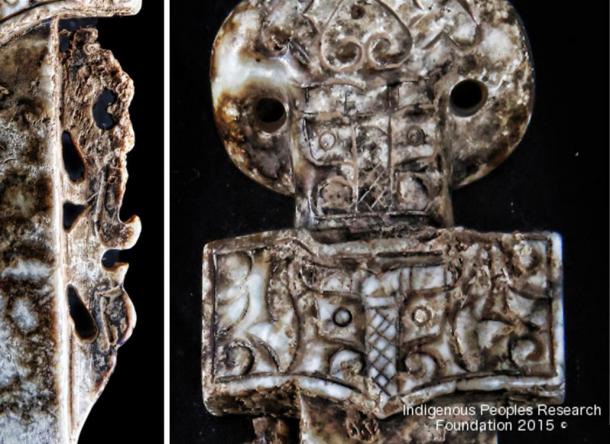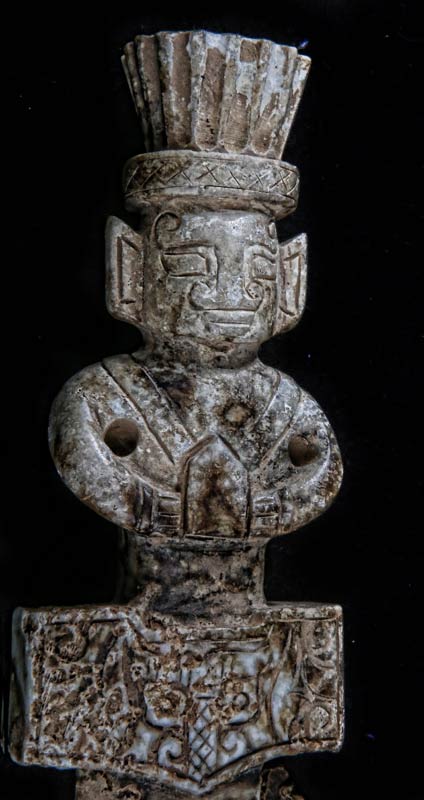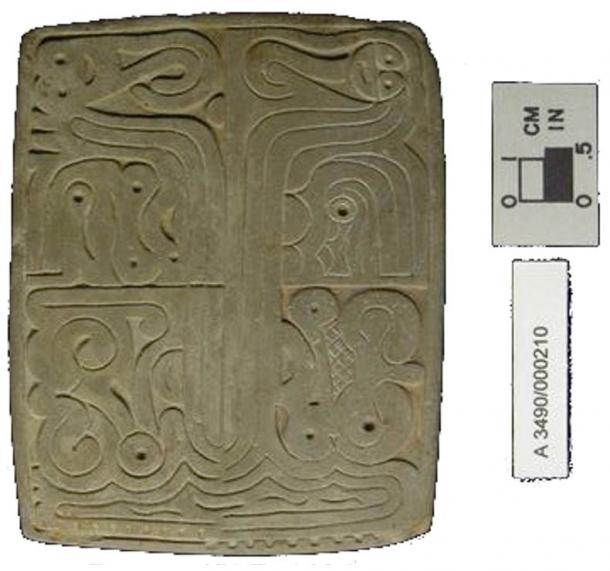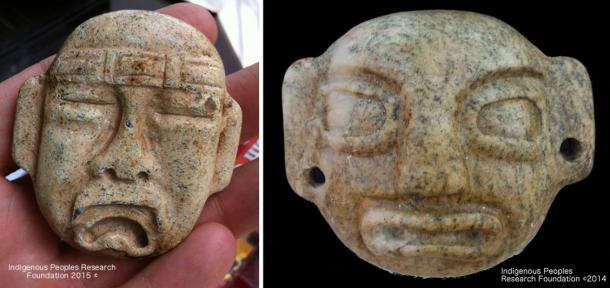Chinese Votive Sword Found in Georgia suggests Pre-Columbian Chinese travel to North America
In July 2014, an avocational surface collector chanced across a partially exposed Chinese votive sword behind roots in an eroded bank of a small stream in Georgia. The 30 cm artifact is possibly a one-of-a kind find in North America and is another example in the growing list of seemingly out-of-place Chinese artifacts suggesting Chinese travel to North America in Pre-Columbian times.
The exquisite sword has preliminarily been identified as being fashioned in Lizardite and has surface features indicating it is very old. It is hoped that future testing will confirm the type of stone, and determine the source, since Lizardite deposits exist in both eastern and western hemispheres.
Answers to the when, who, and how questions remain uncertain. An attempt to determine when the soil at the extraction site was last exposed to sunlight with thermoluminescence testing procedures, was thwarted because it was determined the soil had been disturbed. There remains a small section of an unknown stranded material still attached to the sword which may be suitable for radiocarbon dating, and also select areas of surface accretions that may produce helpful information.
Chinese symbology
Less uncertain are the many symbols and the shape of the sword, both of which are found on jade objects from the Xia (2070-1600 BC), Shang (1600-1046 BC) and Zhou Dynasty (1046-256 BC). The dragon figure spanning a portion of the top of the blade is typical to the Shang Dynasty, as is the feathered crown. The grotesque face mask of the Taotie on the guard and handle of the sword, first appears during the Liangzhu culture (3400-2250 BC) but it is more commonly found during the Shang and Zhou periods. (Siu-Leung Lee, PhD, personal conversation, and soon to be published paper.)

Left: Close up of dragon Right: Close up of Taotie in this general area. Photo courtesy of the Indigenous Peoples Research Foundation.
The dominant presence of Shang period diagnostics and the similarity of the Taotie to depictions of the Mesoamerican Olmec w ere-jaguar, provide clues as to when the sword was made and a general time frame for when it may have arrived in Georgia.
Chinese – Olmec connection?
The similarity of Chinese-Olmec mythology and symbolism has been the subject of scholarly debate for over one hundred years. It is perhaps no coincidence that the Olmec culture appears around 1500 BC during the beginning of the Shang Dynasty, and the first written history of China begins. It was the start of the Bronze Age resulting in ornate bronze works of art, bronze chariots and weaponry. The first Chinese script appears at this time along with extensive irrigation systems and other public works projects, all indicators of a sophisticated and advanced culture.
It was also a time in Chinese culture when Jade was more valuable than gold, and likewise with the Olmec elite who had Jade deposits located in now Honduras and Guatemala. It may not be coincidental the Olmec, during their Middle Formative period (900-300 BC), mastered the difficulties of shaping and drilling Jade (a stone so hard that it cannot be worked with steel tools), with abrasive materials into small ornamental and votive pieces. The similarities of Chinese-Olmec art is quite telling and for those interested, an excellent comparison is presented in Art and Ritual in Early Chinese and Mesoamerican Cultures , Santiago Gonzalez Villajos, 2009.
The likely introduction of Chinese concepts of rulership and a stratified society, along with their religion and symbolism no doubt altered the Olmec and later Mesoamerican groups. It was an event that would be repeated in the 16 th century when Spanish Friars waded ashore carrying the cross of Christianity.

Reverse side of the votive sword. Photo courtesy of the Indigenous Peoples Research Foundation.
How did the sword get to Georgia?…some possibilities
Around 900 BC, these new Olmec cultural attributes started to spread throughout the region. There is considerable literature indicating that they served as a foundation for other contemporaneous and subsequent cultural groups, such as the Maya. Though modified by other groups to meet local needs and with changes over time, the basic concepts of the Olmecs persisted into the 16 th century conquest period. Interestingly, some of these ancient concepts, such as those relating to the planting of maize, are still practiced today within certain Mesoamerican indigenous groups. It is generally believed this dispersal was a by-product of the Olmec land and coastal maritime trade routes transporting basic and exotic trade goods.
An intriguing element to this cultural phenomenon, and why it is mentioned, is that it starts around 900 BC, which as mentioned previously, is when the Olmec started making Jade ceremonial objects.
An example that illustrates the geographic extent of this cultural diffusion is the distribution of flat and cylindrical printing seals, a technology that first appears in the Mesoamerica artifact record with the Olmec. In China, printing seals first appear during the Shang Dynasty.
Olmec traditions spread north
By 800 BC, the seals were in use in northern South America some 1700 miles south of the Olmec heartland, and an equal distance to the north with the Adena Culture (800 BC-1 AD) in the upper Ohio River Valley in North America. Not only did the printing technology arrive in Ohio but also Olmec art. In an unpublished research project on the Adena tablet shown below, this author found stylistic duplicates of the unique center vertical element representing the World Tree, at the Lake Chalco region south of now Mexico City and at Veracruz on the Gulf coast.

Printing Seal from the Adena Culture. Photo courtesy of the Ohio Historical Society
The arrival of seals at the beginning of the transformational mound building Adena culture, along with other evidence too numerous to include in this short article, indicates that an influential Mesoamerican group entered the region and influenced the cultural destiny of the local population.
Returning to Georgia. In 1685, Charles de Rochefort in his chronicles regarding the Apalachites who occupied the lands in southeastern America in the 17 th century, writes,
“Thefe Apalachites boaft, that they had propagated certain Colonies a great way into Mexico: And they fhow to this day a great Road by land, by which they affirm that their Forces march’d into thofe parts… The Inhabitants of the Country, upon their arrival gave them the name of Tlatuici, which fignifies Mountaineers or High-Landers…”.
Rochefort also writes, “This people [Apalachites] have a communication with the Sea of the Great Gulf of Mexico or New Spain, by means of a River”…the Spaniards have called this River Riu del Spirito Santo” [Mississippi River].
While Rochefort’s observations are from after the Conquest Period, his observations highlight a geographic fact that is often overlooked or minimized in North American history. The various cultures occupying the lands of now Georgia and other States fronting on the Gulf of Mexico, along with the Caribbean Islands, Mexico, and South America, were in a circum-Caribbean region where everyone knew their neighbors. One can therefore reasonably assume that this is the reason is why ball courts and rubber balls are found in both mainland Mesoamerica and the Caribbean Islands.
Also, one cannot overlook that the Olmec and Maya had a fleet of large ocean going canoes plying the coastal waters of the Gulf region, and the logistical organization to supply the basic needs of major urban areas with population densities equal to today’s major cities. For example, salt, a basic requirement for survival in the tropics, needed in countless tons per month, was shipped from salt producing facilities in the Yucatan to known river ports stretching from the Honduran Moskito Coast to Tampico, Mexico.
Other than being a wet and scary experience with no life preservers in rough seas off the Moskito Coast, I can attest based on multiple trips, the dugout log design works very well. Even today, with the exception of Yamaha outboard motors, these vessels which have not changed in manufacture or design since the Maya, still transport tons of stacked 50 gallon barrels of gasoline, food stuffs and people into the Honduran interior.
In the Greater Antilles, the impressive Taino culture, who migrated from Venezuela starting around 400 BC, and the Caribes, were equally adept at traversing the waters of the Gulf of Mexico. Christopher Columbus makes numerous entries in his log of large Taino canoes, measuring approximately 40 to 79 feet in length, laden with trade goods and people. More noteworthy is that his log entries indicate that the Taino knew of the Calusa in Florida and the Maya on the Yucatan.
From all of this it is seems apparent that the circum-Caribbean region cultures, even in more ancient times, were connected by water and land routes, and this furnishes us a possible explanation as to how the sword and two Olmec-style pendants arrived in Georgia.

Olmec Style Pendants found in creek near Chinese votive sword.
Photo courtesy of the Indigenous Peoples Research Foundation.
So, were the Chinese in Georgia?
Part of the answer is the artifact itself. You have to ask why a person would tote around a Votive sword which by definition is an object “expressing a religious vow, wish, or desire: offered or performed as an expression of thanks or devotion to God”, if they were not Chinese.
Secondly, the sword is not the only diagnostic Chinese artifact found nearby. Chinese researcher Dr. Lee disclosed that two other ancient Chinese artifacts have been recently found within a two hour drive of the sword site. He will feature these artifacts in a forthcoming paper. Also, there has been a remarkable number of other Chinese artifacts, rock art script and symbolism located in southwestern America.
Unfortunately in the quest for accuracy in historical and archeological topics, there never seems to be enough data to reach an absolute and non-debatable answer that all can agree with. So at this time the “ were the Chinese in Georgia?” question can only be answered affirmatively when there is a sufficient amount of evidence to rise above an individual’s “Threshold of Believability”.
A closing comment
About 90 years, before Columbus first sailed into Caribbean waters, the Ming Chinese dispatched flotillas under the command of Admiral Zheng He on multiple voyages to the lands around the Indian Ocean to acquire exotic items and materials.
The Admiral’s first expedition consisted of approximately 185 vessels:
- 62 or 63 baoshan or “treasure ships” were constructed for the first expedition, 440′-538′ long by 210′ wide, four decks, nine masts, displacing an estimated 20-30,000 tons, approximately 1/3 to 1/2 the displacement of a current large aircraft carrier.
- Machuan or “horse ships”, 340′ long by 138′ wide, 8 masts, carrying horses, timber for repairs and tribute goods.
- Liangchuan or “grain ships”. 257′ long by 115′ wide, 7 masts, carrying grain for crew and soldiers.
- Zuochuan or “troop ships, 220′ long by 84′ wide, six masts.
- Zhanchuan warships, 165′ long, 5 masts
- 27-28,000 estimated sailors, soldiers, translators and crew members
Related Post
A shocking documentary proves that mermaids do exist
SHOCKING Revelation: Thuya, Mother of Queen Tiye, Was the Grandmother of Akhenaten and Tutankhamun—What Ancient Egyptian Secrets Did She Leave Behind?
Breaking News: Astonishing Discoveries at Karahan Tepe Confirm an Extraterrestrial Civilization is Hiding on Earth, and NO ONE Knows!
Breaking News: Researchers FINALLY Discover U.S. Navy Flight 19 After 75 Years Lost in the Bermuda Triangle!
NASA’s Secret Investigation: Uncovering the Astonishing Mystery of the UFO Crash on the Mountain!
Explosive UFO Docs LEAKED: Startling Proof That Aliens Ruled Ancient Egypt!